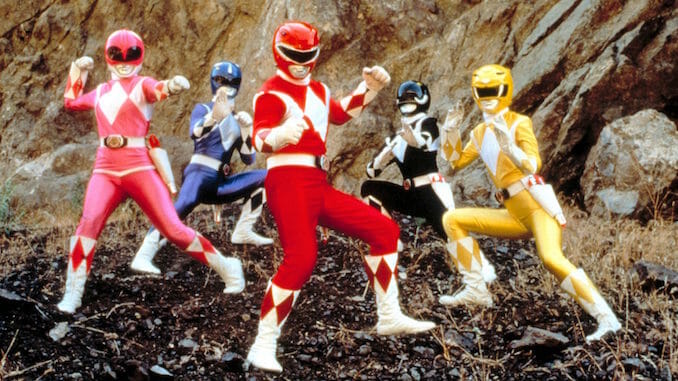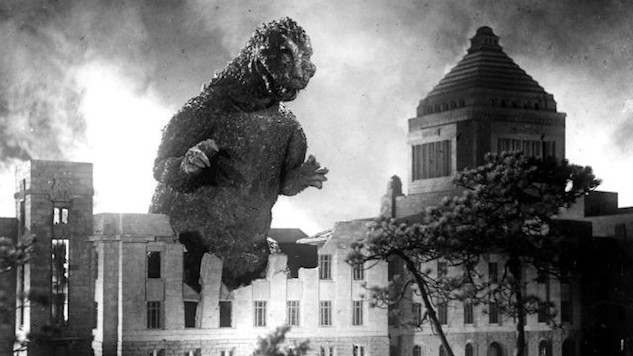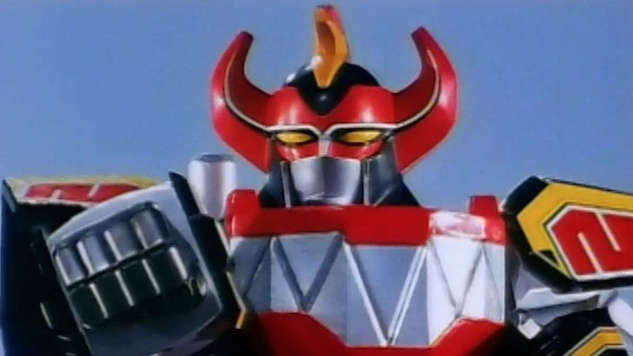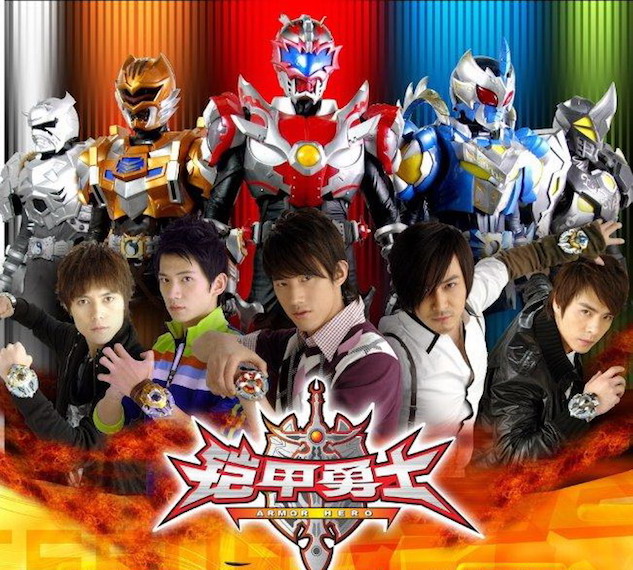Power Rangers and Suitmation: A Love Letter to Tokusatsu TV

In late 1954, a giant, atomic monster rose from the ocean depths to wreak havoc on post-war Japan in director Ishiro Honda’s iconic film Godzilla. It was a movie that would launch not just a globally beloved and resilient franchise but a whole new approach to filmmaking. And for me personally, it was an eye-opening moment that revealed how fantastical illusions, epic in scale and scope, could be created with little more than a goofy rubber suit.
The titular, fire-breathing monstrosity could have been brought to life on the big screen through stop-motion animation, like Merian C. Cooper and Willis H. O’Brien’s inspiring work on the influential King Kong, but special effects artist Eiji Tsuburaya (despite originally hoping to ape the movie monster’s motion) opted to go in another direction. Pioneering the use of so-called suitmation—a human actor suiting up in a monster costume—Godzilla itself was brought to life through a talented special effects team and the performance of suit actors Haruo Nakajima and Katsumi Tezuka. With human-sized monsters battling on scaled-down landscapes and city sets populated with miniatures, shot from low angles and at a high frame rate to give the giants slow, weighty movements, Godzilla became a sensation and the modern tokusatsu era was born.
What Is Tokusatsu?

Technically speaking, the term tokusatsu itself means simply “special filming,” and originates from Japanese kabuki theater, especially in the use of puppetry. But for the purposes of this love letter to the technique, I’ll define tokusatsu as filmmaking that uses suitmation to bring monsters (kaiju) and their giant forms (daikaiju) to life on screen as they antagonize the “good guys,” so-called Kyodai Heroes (costumed superheroes and/or robots who can also grow to immense sizes), in scaled-up battles that take place in worlds awash in sci-fi, fantasy, horror, and mecha mythologies.
TL;DR, tokusatsu as it’s used here is the “Godzilla effect.”
That effect, like any novel and super-popular innovation, inspired other creations within the tokusatsu genre. While Godzilla continued its reign on the big screen, Kohan Kawauchi brought the filmmaking style to television in 1958 with the black-and-white Moonlight Mask. Eiji Tsuburaya himself also created another world-famous series, Ultraman, in the 1960s. Tokusatsu TV continued to explode and expand in the 1970s with the rise of Kamen Rider and similar also-rans. A veritable treasure trove of Japanese tokusatsu TV titles awaits you, dear Googler, but few titles made their way into the West; fewer still generated any lasting popularity.
All of those titles were before my time, as I’d imagine they probably were for you, too. But there’s one that stands out from my childhood, one that had the “Go! Go!” staying power to not only find success in the West but to start a brand new wave of tokusatsu fervor.
Mighty Morphin’ Time

Don’t put on your hypercolored helmet and start singing the theme song just yet! Yes, Power Rangers was the ‘90s version of Godzilla in terms of hype and the introduction of Japanese storytelling to Western markets, but that warm welcome was helped, in part, by the cultural runway that early adopters of anime, manga, and tokusatsu series had built before its arrival. Take, for example, the U.S. release of Ultraman: Towards the Future, an English dub of the joint Japan-Australia production of Ultraman Great, which debuted in the U.S. in early 1992.
That short-lived series, perhaps surprisingly, is my first memory of tokusatsu TV. I undoubtedly have the tie-in toys to thank, as well as the marketing that convinced my parents to buy the plastic figures and scaled-down cityscape playset. I loved those basic, simplistic, and imagination-sparking toys to death, all the better to prepare my own fan interest in what was to come.
Power Rangers, Saban Entertainment’s masterful edit and rework of Toei Company’s Super Sentai series, debuted in 1993, precisely on my 10th birthday. Its brightly colored heroes, supersized mecha and monsters, and ‘90s-saturated California teen aesthetic was exactly what I needed at the time, even if everyone at school was too cool to admit they loved the zany new show despite secretly watching every new episode as it aired.
What began as empty-calorie kids TV has since morphed into a long-lasting franchise that continues today, thanks in part to the brilliant stroke of using existing Super Sentai footage intercut with newly shot English-speaking actors, allowing the show to see what its Japanese counterpart was doing and prepare scripts, sets, and the all-important toy tie-ins well in advance. So even after I had long stopped watching the ever-evolving stories of Power Rangers, its legacy is still being written after almost 30 years on air.
The Halcyon Days of ‘90s Tokusatsu TV

When Power Rangers debuted, it was an out-of-the-box smash hit, a success that belied the long road to production that Haim Saban embarked on. It had taken years for networks to recognize the potential of Saban’s mash-up creation, but mere weeks and months for those same networks and production studios to scramble for a similar title of their own.
What I remember almost as vividly as Power Rangers were all of the copycats it spawned. Some were launched by Saban and Toei themselves, doubling down on a successful strategy with relatively minimal cost compared to new shows created from the ground up. These included the relatively successful VR Troopers, a trendy, techy take on Japan’s Metal Hero Series, with edited footage from three separate series stitched together into one; Masked Rider, a smart but less enduring edit of Japan’s popular Kamen Rider series; and, perhaps my favorite, Big Bad Beetleborgs, a bizarre genre mash-up that also pulled from Metal Hero titles Juukou: B-Fighter and B-Fighter Kabuto, and even featured tokusatsu takes on classic movie monsters like Dracula, Frankenstein’s monster, the Wolfman, and the Mummy.
Not one to be left out of the tokusatsu fun, DIC Entertainment (as DiC Enterprises at the time), teamed up with the likes of Tsuburaya Productions for the surprisingly star-studded Superhuman Samurai Syber-Squad, which starred Matthew Lawrence, Tim Curry, Kath Soucie, and Neil Ross in an English-speaking edit of Japan’s Gridman the Hyper Agent. Another one of my favorites, this series opted to play with scale even more, shrinking our heroes down so that their super-suited versions might battle mega-viruses within a digital computer world; cool stuff.
Another of DiC’s attempts was… not so great. Tattooed Teenage Alien Fighters From Beverly Hills was more of a parody, with no Japanese counterpart to pull from (and it shows). Was this the beginning of the end of the tokusatsu craze, outside of Power Rangers’ dominance?
While all of these tokusatsu series ran in the mid-to-late ‘90s, they were mostly considered a flash-in-the-pan by the end of the decade. (Technically, the ‘97 series Ninja Turtles: The Next Mutation shouldn’t count among such tokusatsu titles in this list, but we’ll throw them a bone here thanks to a crossover with the ever-popular Power Rangers.)
Other titles not quite making the cut thanks to this definition include shows with abysmally immature computer-generated graphics as stand-ins for suited monsters, like those in Mystic Knights of Tir Na Nog, Van-Pires, Los Luchadores, and Galidor: Defenders of the Outer Dimension. Dark times, my friends. Dark times. But is there a place for a tokusatsu comeback in the 21st century?
Where Is Tokusatsu Now?

While there was an attempt to reignite the passion for novel tokusatsu series and English-speaking versions, notable titles are few and far between.
There was the 2002 dub of Ultraman Tiga by 4Kids Entertainment and Fox Box, the heir apparent to the Fox Kids programming block. The heavily edited and satirized version of the Ultraman mythology didn’t do itself any favors. Toei’s Kamen Rider: Dragon Knight fared better when it launched in 2008, even winning a Daytime Emmy for “Outstanding Stunt Coordinator.” But… yeah, that was about it. Even the most recent attempt at a resurgence left the super-suited elements of tokusatsu behind in favor of CG-heavy versions, like Ultraman, a 2019 Netflix anime series that continued the franchise but without the beloved suitmation or any live-action at all.
But there is still hope.
While the West may have given up on tokusatsu outside of Power Rangers, other Asian countries continue to explore the subgenre. In 2006, Thailand launched Sport Ranger (fans of which had to wait until 2012 for a second season), while South Korea debuted the unfortunately titled Erexion. The Philippines introduced their sanctioned spinoff of Toei’s Space Sheriff Shaider as the poorly received Zaido: Pulis Pangkalawakan in 2007, followed by China’s launch of Armor Hero in 2008. China continued the trend in the 2010s with Battle Strike Team: Giant Saver in 2012 and Metal Kaiser in 2013, the same year as Indonesia’s BIMA Satria Garuda. Vietnam got into the mix a bit late in the game with the 2019 effort Mighty Guardian, making it the latest such series to carry the tokusatsu torch.
And yet, few of these productions got a full run—and none of those names are recognizable, let alone popular—in the West. It’s possible that some upstart production company or streaming service looking to make a statement could attempt to catch Saban’s super-suited lightning in a bottle by bringing one of the above-mentioned series overseas, but that’s a tough task, and one that has yet to be announced.
A Better, Super-Suited Tomorrow

With today’s incredible filmmaking technology literally in the palms of our hands, it’s far easier to cook up a fully digital tale than materially and physically craft a literal, well, tail, nevermind the rest of the kaiju suit. Guillermo del Toro gave it his best shot by adding weight and semi-realistic physics to digital creations in his own 2013 tokusatsu love letter Pacific Rim; the same is true for Anne Hathaway’s monstrous connection to a daikaiju in 2016’s Colossal. But even the most realistic-looking creations are never going to have the look, feel, and loveable jank that suitmation gloriously gives us.
As we’re rapidly approaching the 100th anniversary of Harry O. Hoyt’s The Lost World and O’Brien’s iconic effects work in that gem, perhaps a new generation of filmmakers will unearth both stop-motion and suitmation techniques all over again. Modern suits aping animals, dinosaurs, robots, and other super-sized creatures are surprisingly realistic and relatively inexpensive; you can now hire a dinosaur to come terrorize kids at a birthday party if you want to. How has this not become the gateway to a whole new wave of scaled-up storytelling already?
What I’m saying is, we have the tokusatsu technology; we simply lack the will to use it. So suit up, and get yourself out there. We puny humans are counting on you.
Dave Trumbore is a writer and former Senior Editor of Collider.com, as well as the author of The Science of Breaking Bad. For more on TV, movies, animation, and games, you can follow him @DrClawMD or in Big Bad Beetleborgs forums.
For all the latest TV news, reviews, lists and features, follow @Paste_TV.







































